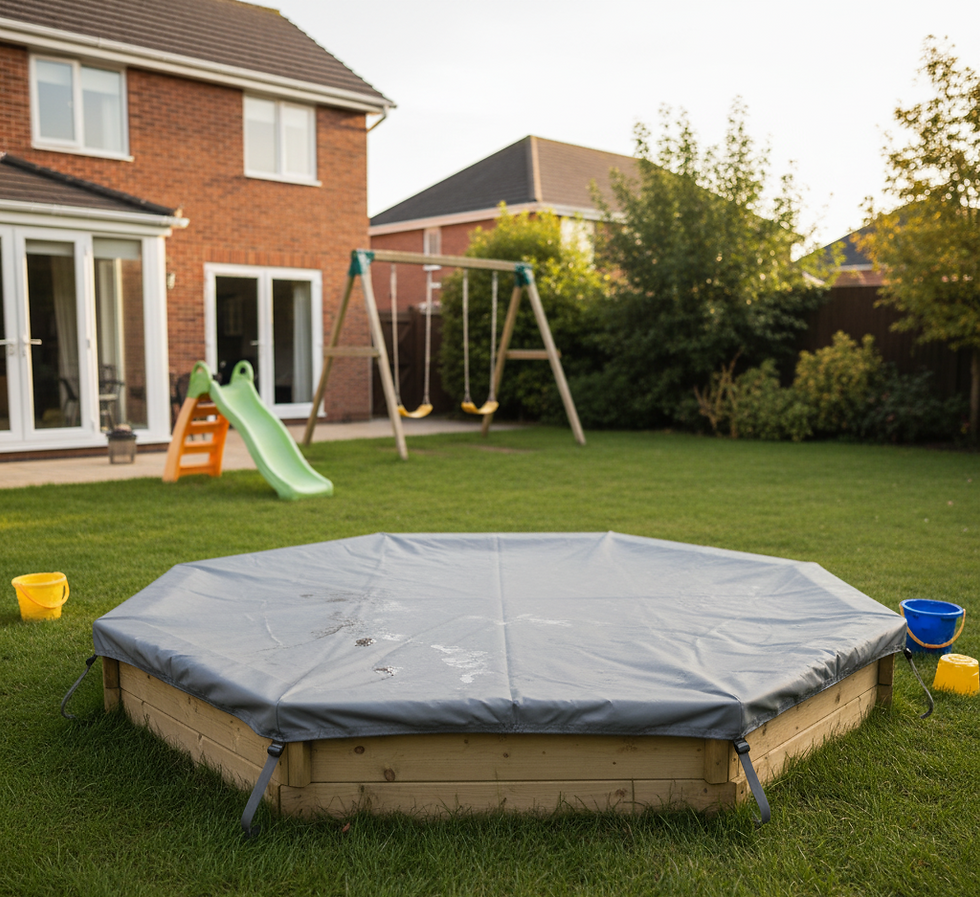How to Install a Sandpit Cover: Step-by-Step Guide for Parents
- Kate Westall
- Oct 10
- 6 min read
Have you ever watched your kids’ faces light up as they dig into a sandpit, building castles or baking pretend cakes? A sandpit in your Aussie backyard can be a magical playground, but without a proper sandpit cover, it can quickly become a haven for cats, leaves, or worse—rain-soaked sludge. Installing a sandpit cover is the key to keeping that sandy paradise clean, safe, and ready for play, especially in Australia’s unpredictable weather.

This guide is tailored for Australian parents, whether you’re in Melbourne’s variable climate or sunny Perth, and walks you through installing a sandpit cover step-by-step. We’ll cover everything from choosing the right cover to ensuring it meets local safety needs, with tips on maintenance and avoiding common pitfalls. Whether you’re a DIY pro or a first-timer, you’ll have a secure sandpit cover in no time, keeping your kids’ play space pristine.
Why a Sandpit Cover Is Essential in Australia
A sandpit cover isn’t just an accessory—it’s a must-have for any Australian backyard with a sandpit. From keeping out curious wildlife to protecting against harsh sun or sudden storms, a cover ensures your sandpit stays hygienic and usable year-round.
Benefits of a Sandpit Cover
Hygiene: Prevents animal waste (like cat faeces, which can carry toxoplasmosis) and debris like leaves or twigs.
Weather Protection: Shields sand from rain, common in places like Melbourne, and UV damage in sunny Queensland.
Safety: Reduces risks of pests or contaminants, ensuring a safe play environment.
Longevity: Extends the life of your sandpit by minimizing sand replacement and structural wear.
In Australia, where outdoor play is a cultural staple, a sandpit cover keeps the fun going without constant clean-up. For example, families in Sydney’s coastal suburbs face salty air and frequent rain, making a durable cover critical.
Australian Considerations
Local councils, like those in Brisbane or Adelaide, often have guidelines for backyard play equipment, emphasizing safety and hygiene. A sandpit cover aligns with these by preventing contamination. Plus, Australia’s love for outdoor living means your sandpit will see heavy use—making a cover a practical investment for busy parents.
Choosing the Right Sandpit Cover
Not all sandpit covers are created equal. Your choice depends on your sandpit’s size, material, and local conditions.
Types of Sandpit Covers
Mesh Covers: Breathable, allowing air circulation while blocking debris. Ideal for humid areas like Cairns to prevent mould.
Solid Covers: Made from marine ply or plastic, offering maximum protection against rain and animals. Popular in Melbourne for weather resistance.
Tarp Covers: Budget-friendly but less durable, prone to tearing in windy Adelaide conditions.
Custom Covers: Tailored to fit unique sandpit shapes, often supplied by local providers like Outdoor Living Direct in Perth.
Factors to Consider
Size and Fit: Measure your sandpit (length, width, depth) to ensure a snug fit. A 1.5m x 1.5m sandpit needs a slightly larger cover to overlap edges.
Material: Choose UV-stabilized plastic or treated timber for durability in Australia’s harsh sun. Mesh should be heavy-duty to resist tearing.
Ease of Use: Look for handles or lightweight designs for easy removal, especially for frequent use.
Local Suppliers: Companies like Bunnings or Mitre 10 stock covers, while Aussie brands like Coolaroo offer UV-resistant options.
Step-by-Step Guide to Installing a Sandpit Cover
Installing a sandpit cover is straightforward with the right approach. Follow these steps to ensure a secure, long-lasting setup.
Step 1: Measure and Prepare Your Sandpit
Measure Accurately: Record your sandpit’s dimensions, adding 10–15cm on each side for overlap to prevent gaps.
Check the Base: Ensure the sandpit frame is level and free of sharp edges. Sand down timber frames to avoid snags.
Clear Debris: Remove toys, leaves, or excess sand to create a smooth surface for the cover.
Step 2: Choose and Purchase Your Cover
Select a cover based on your sandpit type and local weather. For example, a solid cover suits Tasmania’s wet winters, while mesh works in dry Alice Springs.
Buy from reputable suppliers like Bunnings, Outdoor Living Direct, or local manufacturers in Sydney or Brisbane for quality assurance.
Budget: Expect $50–$150 for a standard cover, with custom options costing $200+.
Step 3: Install the Cover
For Mesh or Tarp Covers:
Lay the cover over the sandpit, ensuring even overlap on all sides.
Secure with stakes, bungee cords, or weights (e.g., sandbags) at corners. Use rust-resistant fittings for coastal areas like the Gold Coast.
Check for tautness to prevent sagging, which can collect water or debris.
For Solid Covers:
Place the cover (e.g., marine ply) over the sandpit, ensuring it sits flush.
Attach hinges or handles for easy removal, using galvanized screws to resist rust.
Add a latch or lock to prevent kids from lifting it unsupervised.
Step 4: Test and Adjust
Test the cover’s fit by gently tugging edges to ensure it stays in place.
Simulate rain by sprinkling water to check for pooling. Adjust drainage or tighten the cover if needed.
Ensure adults can remove the cover easily but it’s secure against kids or animals.
Step 5: Regular Maintenance
Check monthly for wear, especially after storms. Repair tears in mesh covers with UV-resistant thread.
Clean solid covers with mild soap and water to prevent mould, common in humid Brisbane.
Reapply UV protectant sprays to plastic covers every 6 months to combat Australia’s sun.
Safety and Local Regulations
Safety is paramount when installing a sandpit cover, especially for Aussie families.
Safety Tips
Child-Safe Design: Ensure covers are too heavy or complex for kids to lift, preventing entrapment risks.
Smooth Edges: Sand or round off timber cover edges to avoid splinters or injuries.
Ventilation: Mesh covers should allow air circulation to prevent moisture buildup, reducing mould risks.
Australian Regulations
Council Guidelines: Some councils, like City of Melbourne, require play equipment to meet safety standards (e.g., AS 4685 for playgrounds). Check local rules via council websites.
Animal Control: Covers help comply with hygiene regulations by preventing animal contamination, a concern in areas like Canberra with urban wildlife.
Neighbour Considerations: Ensure covers don’t create noise (e.g., flapping tarps) that could breach noise bylaws in quiet suburbs like Adelaide’s Unley.
Maintaining Your Sandpit Cover
A sandpit cover requires regular upkeep to stay effective:
Daily Checks: Remove leaves or debris to prevent staining or mould.
Monthly Cleaning: Wash covers with a hose and mild detergent. Dry thoroughly to avoid mildew.
Seasonal Care: In winter, check for waterlogging and tighten fixings after storms. In summer, apply UV protectant to prevent fading.
Replacement: Replace mesh covers every 2–3 years or when tears appear. Solid covers may last 5+ years with proper care.

Questions and Answers: Common Questions About Sandpit Covers in Australia
Q: Why do I need a sandpit cover in Australia?Ans: A sandpit cover protects against animal waste, debris, and weather, keeping the sand hygienic and safe. In Australia, where cats and possums are common in suburban areas like Sydney, a cover prevents contamination and ensures year-round play.
Q: What’s the best material for a sandpit cover in Australia’s climate?
Ans: UV-stabilized plastic or marine ply is ideal for durability against Australia’s sun and rain. Mesh covers work well in humid areas like Queensland, allowing ventilation while blocking debris.
Q: How much does a sandpit cover cost in Australia?
Ans: Standard covers cost $50–$150 at retailers like Bunnings or Mitre 10. Custom covers from local suppliers like Outdoor Living Direct in Perth may cost $200–$400, depending on size and material.
Q: Can I make my own sandpit cover?
Ans: Yes, DIY covers using marine ply or heavy-duty mesh are cost-effective. For a 1.5m x 1.5m sandpit, expect to spend $50–$100 on materials. Ensure proper fit and use child-safe, weather-resistant fixings.
Q: Are there regulations for sandpit covers in Australia?
Ans: While not specific to covers, councils like Brisbane City require play equipment to meet safety and hygiene standards (e.g., AS 4685). Check local guidelines to ensure compliance, especially for protected areas or shared spaces.
Conclusion: Your Path to a Successful Sandpit Cover in Australia
Installing a sandpit cover is a simple yet essential step to keep your children’s backyard play space safe, clean, and fun. By choosing the right cover, following a clear installation process, and maintaining it against Australia’s diverse weather, you’ll ensure your sandpit remains a joyful haven for years. From Melbourne’s rainy winters to Darwin’s humid summers, a well-installed sandpit cover protects against animals, debris, and UV damage while meeting local safety standards.
Your next steps are straightforward: measure your sandpit, select a durable cover from trusted suppliers like Shade Wise, and follow our step-by-step guide to install it securely. Regular maintenance and safety checks will keep it in top shape. With a sandpit cover in place, you can relax knowing your kids are playing in a hygienic, protected space, creating memories that’ll last a lifetime in your Aussie backyard.









Comments